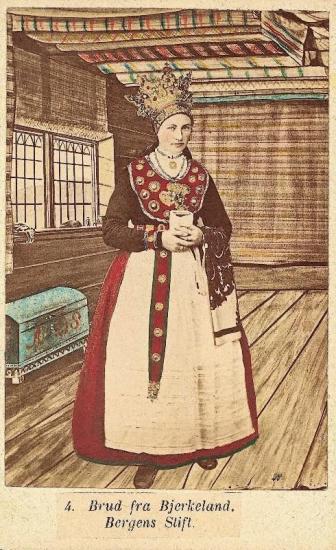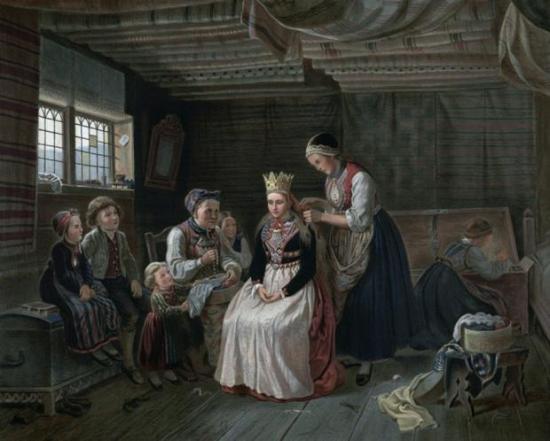Marrying for love and romance hasn’t been around nearly as long as the 700 year old tradition of bride gifts.
Ingrid P. Nuse
Source - http://sciencenordic.com/wedding-gifts-came-and-went


Illustration of a young couple from the publication Norsk bondeliv [Norwegian farmer’s life], published in the 1850s. (Picture: Adolph Tidemand)
Wedding traditions come and go. But one wedding custom in particular dates all the way back to the 1100s, and Herleik Baklid has investigated sagas, kings’ letters, wills, court records, and old laws to find traces of it.
That would be the custom of bride gifts, a folk tradition that was kept alive until the mid-1800s, when a new Norwegian law abolished the bride’s right to these gifts. Baklid conducted the research for his recent doctorate in the Department of Culture Studies and Oriental Languages at the University of Oslo.
If not for love, then what?
Back in the day, until a little over a century ago, “this was a society without government social welfare programmes,” says Baklid. “So the groom and his future in-laws were responsible for creating economic security for the bride.”
Today’s gifts of kitchenware, silverware and gorgeous designer items are a far cry from earlier ideas of top-notch wedding presents. Well into the 1700s, marriage had a very different purpose from now.
Before marrying for love came into the picture, the primary intention of a couple’s union was economic. Throughout history, it turns out that the groom often gave one or more traditional gifts to the bride.
According to Baklid, the bride could draw on these gifts if she became widowed. The basic principle underlying the gifts was that she would be financially secure if her husband died.
Gift showering
Baklid found evidence of three different categories of bride gifts that existed since medieval times. The groom-to-be was responsible for the “festegave,” an engagement present; the “benkegave,” akin to a bride price; and the “morgengave,” or morning gift given after the wedding night.
 This illustration by Adolph Tidemand shows the extensive process brides went through to prepare for the wedding ceremony. (Photo: Wikimedia Commons, National Library of Norway)
This illustration by Adolph Tidemand shows the extensive process brides went through to prepare for the wedding ceremony. (Photo: Wikimedia Commons, National Library of Norway)
Marriage as an economic affair lasted from medieval times until the late 1700s and early 1800s, and it was generally negotiated between the bride and groom's families. Upon reaching an agreement, the showering of gifts from the future groom began.
The festegave was given at the betrothal, and was a gift to strengthen (or “fasten”) the marriage agreement. The gift could range from silver spoons or teapots and jewellery to land. The bride was entitled to claim all this as hers, should she become a widow. With the betrothal “in the bank,” the couple was then considered engaged, says Baklid.
More light-hearted over time
Before the actual wedding ceremony, the groom had to come with promises of gifts that would convince the bride to leave her parents. Usually various parties would negotiate on the bride and groom's behalf, where the bride would "be released from the bench", i.e. stop sleeping on the bed in her parents’ home. Hence the name of the second traditional gift: benkegave, or “bench gift”.
The benkegave is most likely connected to the custom of a bride price, an even older tradition. Simply put, with this bride gift the groom says what he is willing to pay for his future wife. The benkegave could consist of anything, from horse and saddle to jewellery and property.
Later this custom turned into informal entertainment in the wedding celebration. Ørnulf Hodne recounts an example in his book Kvinne og mann i norsk folkekultur [Woman and man in Norwegian folk culture], in which the bride was "bought" for all the granite that lay six meters below the Tisleia river.
It was of course an extra big deal for the bride's parents if high sums of money were bid.
One last gift at dawn
The oldest of the three gift practices is the morgengave, or morning gift. Still a tradition in some (especially Germanic) cultures, it can be traced all the way back to the Roman Empire, according to Baklid. The groom gave his bride this final gift the morning after the wedding night.
The options were many for the morning gift. Knud Nielsen from Tinn in Telemark, for example, gave Helge Torgrimsdatter a horse, a saddle, three pelts and 120 rix-dollars as a bride price and morning gift.
Among royalty and the upper class, land and estates could constitute the morning gift.
Keep property within the family
“This was an agricultural society where social status was tied to how much land a family had. So you had to make sure to keep all the land within the family,” said Baklid.
Often a widow took over management of the property she had received as a gift from her late husband. Sometimes it could also revert to her husband's family, depending on the agreement that had been made.
Various wedding outfits are pictured from Marcus Selmer’s photo series Norske Nationaldragter [Norwegian national costumes]. The women were photographed in a studio, and the background was drawn in later and the pictures coloured by hand.
Royal origins
Baklid cannot say for sure exactly where these customs come from. But they have been around since before the Christian church introduced its marriage regulations, around 1270. Most likely, they first occurred among the higher social strata and were later taken up by the lower social classes.
An example cited in Kulturhistorisk leksikon for nordisk middelalder [Encyclopaedia of old Norse literature and culture] was the agreement made when the 14-year-old Norwegian king Eirik Magnusson and 20-year-old Margaret of Scotland married in 1281.
 Photograph of a wedding procession from around 1890. By then the custom of bride gifts had diminished, but the beautiful folk costumes were retained. (Photo: Axel Lindahl. Used with permission from Norwegian Folk Museum)
Photograph of a wedding procession from around 1890. By then the custom of bride gifts had diminished, but the beautiful folk costumes were retained. (Photo: Axel Lindahl. Used with permission from Norwegian Folk Museum)
The queen received sovereignty over a piece of land, and if the King were to die before her, she could claim to a specific sum of money that would be paid her annually. Eventually, she would also receive the money that her parents had given in dowry when she married.
Love and the law play in
In the early 1800s these traditions slowly died out. What surprised Baklid the most is that he found no evidence that the church opposed them. “The gifts’ clear practical-economic function didn’t really conflict with church teachings about marriage,” he says.
In 1854, the Norwegian laws that gave a widow legal claim to the gifts were taken off the books, maybe because they could cause problems in litigation. Instead, expanded inheritance rights replaced the bride gifts.
And then there was the emerging romantic ideal— the notion that you married each other for love, not for economic purposes—that contributed to the demise of these traditions.
Traces of tradition
But one does not have to look too hard to find vestiges of old Norwegian traditions in present-day culture.
Although the bride price has disappeared, the morning gift has seen a resurgence of popularity in Norway, and engagement rings have handily taken the place of betrothal gifts, Baklid says.
Of course, he explains, “the symbolism is perhaps a little different- now the gifts are expressions of love and don’t necessarily provide financial security in the event of widowhood.”